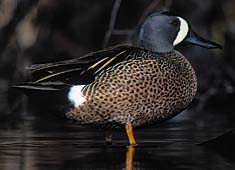|
|
 |
 | |
|
Cross Timbers Ducks
"Listen!" Ron Burk called a quick halt to our pre-dawn climb over the barbed wire fence. Calvin Hudson and I could almost make out Ron's intent face, ear pointed toward the 20-acre lake just beyond the fence.
"Look there," Ron whispered, gesturing toward the barely orange sunrise beyond the lake dam. But it wasn't the sunrise that caught my eye. It was dots against the sky - lots of winged dots that quickly became ducks. Not singles or doubles, either, but hundreds of ducks, all lifting off the lake and heading west. "Holy cow - look at the ducks!" "Told you!" Ron chuckled. "Let's get these decoys out." We quickly hustled to the lake edge, scattered decoys and ducked into cover as shooting time approached with the morning light - and, the likely return of all those ducks. Typical Texas duck story? Sure. Except for one thing: This hunt wasn't taking place on the Texas coast, or even a flooded rice prairie. It was happening within sight of the city lights of Stephenville, smack in the heart of the Cross Timbers and within an hour of the Dallas-Fort Worth Metroplex. This is not traditional duck country, except for those Texans who learned long ago that this region of North-Central Texas offers some of the greatest - and most overlooked - waterfowl hunting in America. The Cross Timbers is a rolling, oak-studded region that stretches from the outskirts of Fort Worth west to Brownwood. The region earned its name from early pioneers who made note of the belts of bottomland timber they crossed between open stretches of prairie - hence "Cross Timbers." Today this region is home to two key Texas agriculture industries: peanuts and milk. Erath County, incidentally, is the number-one dairy county in Texas, with almost 200 dairies. So what does milk have to do with ducks? They both need lots of water. Modern dairies must build hundreds of dairy "lagoons" to catch runoff water. And these waterholes, combined with thousands of conservation lakes, give the ducks countless places to loaf and rest. And then there's the thousands of acres of peanut fields. The ducks just love peanuts, and goobers spilled in the harvested fields provide an almost unlimited food supply. For example, the peanut country around DeLeon, in Eastland County, draws thousands of ducks each fall. The birds gorge on the peanuts and loaf on Lake Proctor and the countless ponds and dairy lagoons in the surrounding area. Hunters who can find a small body of water which the ducks have been using are almost guaranteed a superb hunt, with a chance for a limit of greenhead mallards a real possibility. The variety of ducks is also amazing. Mallards, widgeons, gadwalls, teal, plus the lesser shovelers and diving ducks are all there. Often there are pintails or canvasbacks thrown in, and even a flock of geese occasionally. Last season some of the bigger lakes in the region, like Richland Chambers, were loaded with thousands big, handsome canvasbacks. However, the divers will hit small lakes, too. Fort Worth outdoor writer Jack Demetruk has his own 5-acre duck honey-hole on his 400-acre spread in Bosque County. More than once Jack and I have watched flock after flock of bluebills or redheads diving into our decoys on that little lake. There are a growing number of quality guides in the region. This includes a number of long-time quail outfitters who have shifted more and more to waterfowl hunting during the past two very marginal quail seasons. Combo hunts, blending ducks in the morning with quail or pen-raised chukars and pheasants in the afternoon, are often possible. |
|
|
| |
|
| |
Site design by Copyright © 1996-2007 Outdoor Management Network Inc. America Outdoors® is a registered trademark of Outdoor Management Network Inc. |
 Close to the DFW Metroplex, this pond-studded region may be the best-kept waterfowling secret in Texas.
Close to the DFW Metroplex, this pond-studded region may be the best-kept waterfowling secret in Texas.